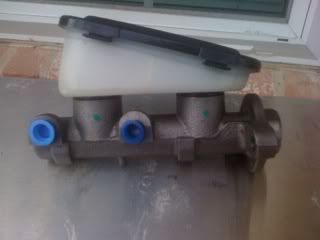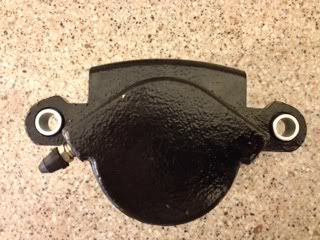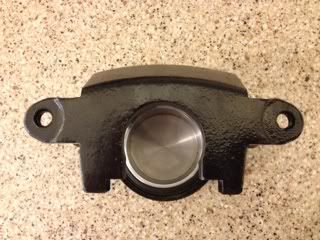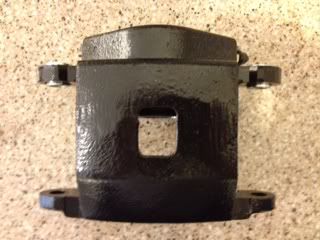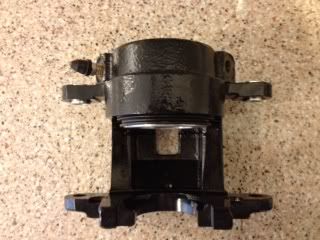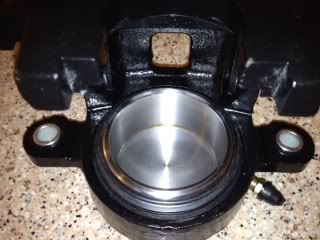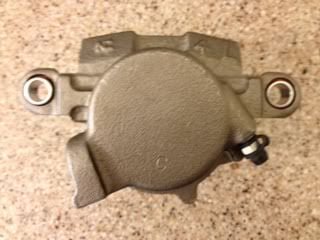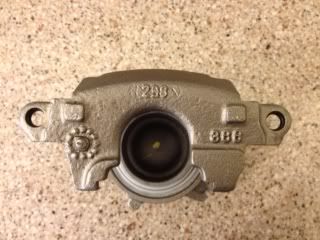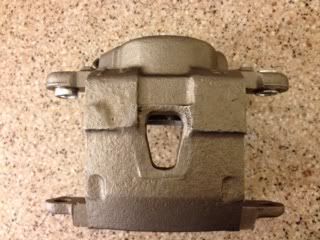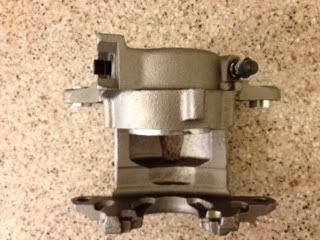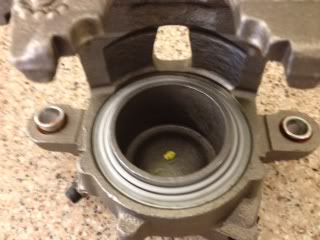I have purchased 3 different metric calipers for comparison:
**CCP big bore 2.75" bore (2.565" piston diameter) metric cast iron caliper – WEIGHT 6 lbs 11.2 oz bare with slider bushings installed
**US Brake standard bore 2.5" bore (2.376" piston diamter) metric cast iron caliper- WEIGHT 6 lbs 4.7 oz bare with slider busings installed
**Wilwood small bore 2.0" bore (1.981" piston diameter) metric cast iron caliper - WEIGHT 4 lbs 1.7 oz bare with NO SLIDER BUSHINGS INSTALLED.
A while back I purchased NEW the $59.95 each, big bore calipers from speedwaymotors.com. There was some manufacturing issues or problems with these calipers and they sent me replacement calipers. The replacement calipers are NEW CCP big bore metric calipers. PN CP412526. Online, these are the same price of $59.95 each from classicperform.com. They look exactly the same except for the paint on the calipers. The originals where painted/powder coated silver. These are painted/powder coated black. The caliper housing, compared the standard bore US Brake 2.5” calipers and 2.0" Wilwood calipers, are a different casting. The piston looks to be stainless steel and comes with a dust boot installed. The piston diameter is 2.565" in diameter. These calipers came loaded with pads, slider bolts/pins, and hose fittings. You should be able to bolt these to your car, bleed the brakes, and drive. The piston cylinder side of the caliper is roughly the same size as the as the standard 2.5” bore caliper.
I recently purchased NEW, US Brake/Afco branded 2.5” standard bore metric calipers. They are $45 to $50 each online. The casting is not painted or powder coated. They come in a right PN 7241-9003 and a left caliper PN 7241-9004. They cannot be interchanged from side to side. The piston looks to be a cast steel/iron, unlike the CCP 2.75” and Wilwood 2.0” bore calipers. They are also 2.376" in diameter which matches stock advertised piston/bore sizes. The casting looks to be a stock casting and comes with a dust boot installed. It has all the markings of a stock calipers. This caliper came unloaded with no pads, slider bolts/pins, and hose fittings. It does come with the bleeder screws and bushing inserts for the slider bolts/pins. You will have to reuse your slider pins from your stock calipers and hose fittings. You will need to purchase new pads or reuse the ones you have on your car.
I also recently purchased NEW, Wilwood 2.0” small bore metric calipers. PN 120-9333. The price is round $80 each online. It is also a different casting from the other two. Visually the casting looks better and it looks to come with a stainless steel piston that is 1.981" in diameter. The casting comes bare with no paint or powder coating and they can be interchanged from the right and left hand side of the car. The piston cylinder portion of the caliper is physically smaller than the other two because of the reduced size of the piston. The piston bore and stainless steel piston look to have a better, tighter fit. The clearance is so tight there is no dust boot installed around the piston like the 2.75” and 2.5” bore caliper above. These calipers only come with a bleeder screw. It does not come with any other hardware. You will have to supply the slider bolts/pins, slider bolt/pin bushing inserts (I need to make sure this is possible), brake pads, and hydraulic hose fittings. All hardware should be able to transfer over from your original caliper. Please refer to this web page for more details.
http://www.wilwood.com/PDF/Flyers/fl176.pdf
Out of the three calipers above, I was most impressed with the Wilwood calipers. These calipers have a very clean casting that weigh at least 2 lbs less than the other two calipers. The Wilwood website list a 2.75” bore version also that weighs just 5 more ounces than the Wilwood 2.0” bore versions (4lb 6.4oz v 4lb 1.6oz). These Wilwood iron calipers weigh roughly 1lb more than the Willwood comparable aluminum metric caliper with the 2.38” bore (4lb 6.4oz v 4lb 1.6oz v 3lb 6.4oz). I also suspect that the piston to bore clearances are just as tight as their 2.0" verson which will give the 2.75" version of the Wilwood caliper a larger piston that that of the CCP version. It theory this gives more clamping force.





